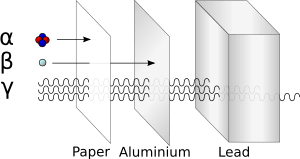Radiation facts for kids

In physics, radiation is when energy moves through space or a material. It can travel as waves or tiny particles.
This includes:
- electromagnetic radiation like radio waves, visible light, and x-rays.
- particle radiation like alpha, beta, and neutron radiation.
- acoustic radiation like ultrasound and sound.
- seismic waves (like those from earthquakes).
Sometimes, "radiation" also means the energy, waves, or particles themselves that are moving.
Contents
Types of Radiation
Many people know about different kinds of electromagnetic radiation, which is also called light. Scientists sort these types of radiation based on their wavelength (how long the waves are) and frequency (how many waves pass by in a second).
Here are some types of electromagnetic radiation:
- Ionizing radiation comes from radioactive materials and x-ray machines. It carries a lot of energy (more than 10 eV, or electronvolts). This energy is enough to change atoms and break chemical bonds. This is why it can be harmful to living things.
- Non-ionizing radiation usually comes from other sources. It does not have enough energy to break chemical bonds. Some types can cause chemical changes or make things hotter, but they don't cause the same kind of microscopic damage as ionizing radiation.
- Radio waves: These waves have the longest wavelength of all electromagnetic radiation. We use radio waves to send and receive communications, like for radio and TV.
- Microwaves: These are a special kind of radio wave. Microwave ovens use them to heat food. Microwaves are also used for communication, and sometimes even as weapons or to move electrical power.
- Radar waves: These are also a type of radio wave. Radar is used to find airplanes in the sky and ships in the ocean. It can also help us see changes in the weather.
- Infrared waves: Most objects around you give off infrared radiation, especially if they are warm. Humans can't see it, but special cameras can. The hotter something is, the more infrared it gives off. This means these cameras can "see" hot things, even through some walls.
- Visible light: This is the radiation we see every day. It's what most people simply call "light."
- Ultraviolet light: This type of radiation has more energy than visible light. It's what gives people a sunburn. Ultraviolet light is also used to kill bacteria and to make some kinds of invisible ink show up.
- X-rays and Gamma rays: These are very powerful rays. Doctors use them to take pictures inside the body and to help treat cancer. However, too much of these rays can be very dangerous to living things.
Dangers of Radiation
Ionizing radiation is radiation that has enough energy to knock electrons away from atoms or molecules.
Only certain types of radiation are harmful to humans. For example, ultraviolet radiation can give you sunburn. X-rays and gamma rays can make a person sick, or even cause serious harm, depending on how much they are exposed to. Some types of particle radiation can also cause sickness and burns.
If radiation does not carry high levels of energy, it won't cause these harmful changes. This is called non-ionizing radiation, and it is generally not as dangerous.
We can tell different types of radiation apart by looking at where they come from, their wavelength (for electromagnetic radiation), how much energy they carry, and what particles are involved. A radioactive material is one that naturally gives off radiation. Uranium and plutonium are examples of radioactive materials. Their atoms are unstable and tend to break apart, releasing different kinds of radiation, like gamma rays and many types of particle radiation.
Types of Ionizing Radiation
Ionizing radiation can harm living things. It can cause changes in genetic material, which is like the body's instruction manual. It can also damage cells in the body that divide, which can make a person very sick.
- Alpha radiation: This is a type of particle radiation. It's made of the centers (called nuclei) of helium atoms.
- Beta radiation: This is another type of particle radiation. It's made of high-energy electrons or positrons.
- Neutron radiation: This is a type of particle radiation made of high-energy neutrons.
- Gamma radiation (Gamma rays): This is a type of radiation made of high-energy photons (packets of light energy).
- X-ray radiation (X-rays): This is also made of photons, but they usually have less energy than gamma rays.
Types of Non-ionizing Radiation
- Ultraviolet radiation (also known as UV).
- Infrared radiation.
- Microwave radiation, which you might know from microwave ovens.
- Radio or Television waves.
- Visible light.
- Gravitational radiation, which scientists believe exists based on general relativity.
Related pages
- Background radiation
- Cosmic microwave background radiation, a faint glow of radiation that fills the Universe
- Radiation sickness - how radiation can harm living things
- Radiation hardening - making devices able to work in places with high radiation
- Radioactive contamination
- Radioactive decay
- Radiation accidents
Images for kids
-
Some kinds of ionizing radiation can be detected in a special device called a cloud chamber.
-
Gamma radiation seen in an isopropanol cloud chamber.
-
An Alpha particle detected in an isopropanol cloud chamber.
-
Electrons (beta radiation) detected in an isopropanol cloud chamber.
-
The electromagnetic spectrum, showing different types of electromagnetic waves.
See also
 In Spanish: Radiación para niños
In Spanish: Radiación para niños







